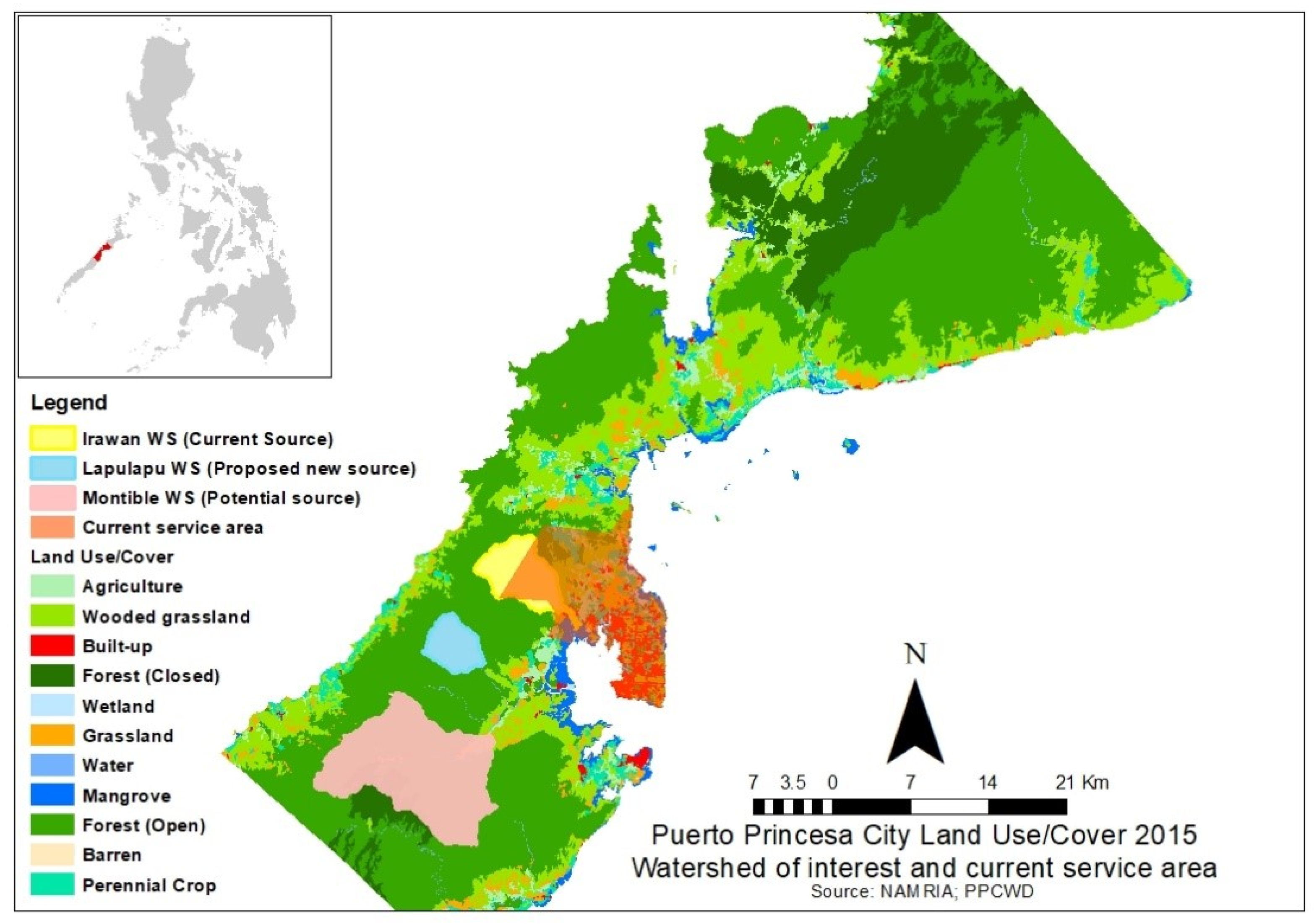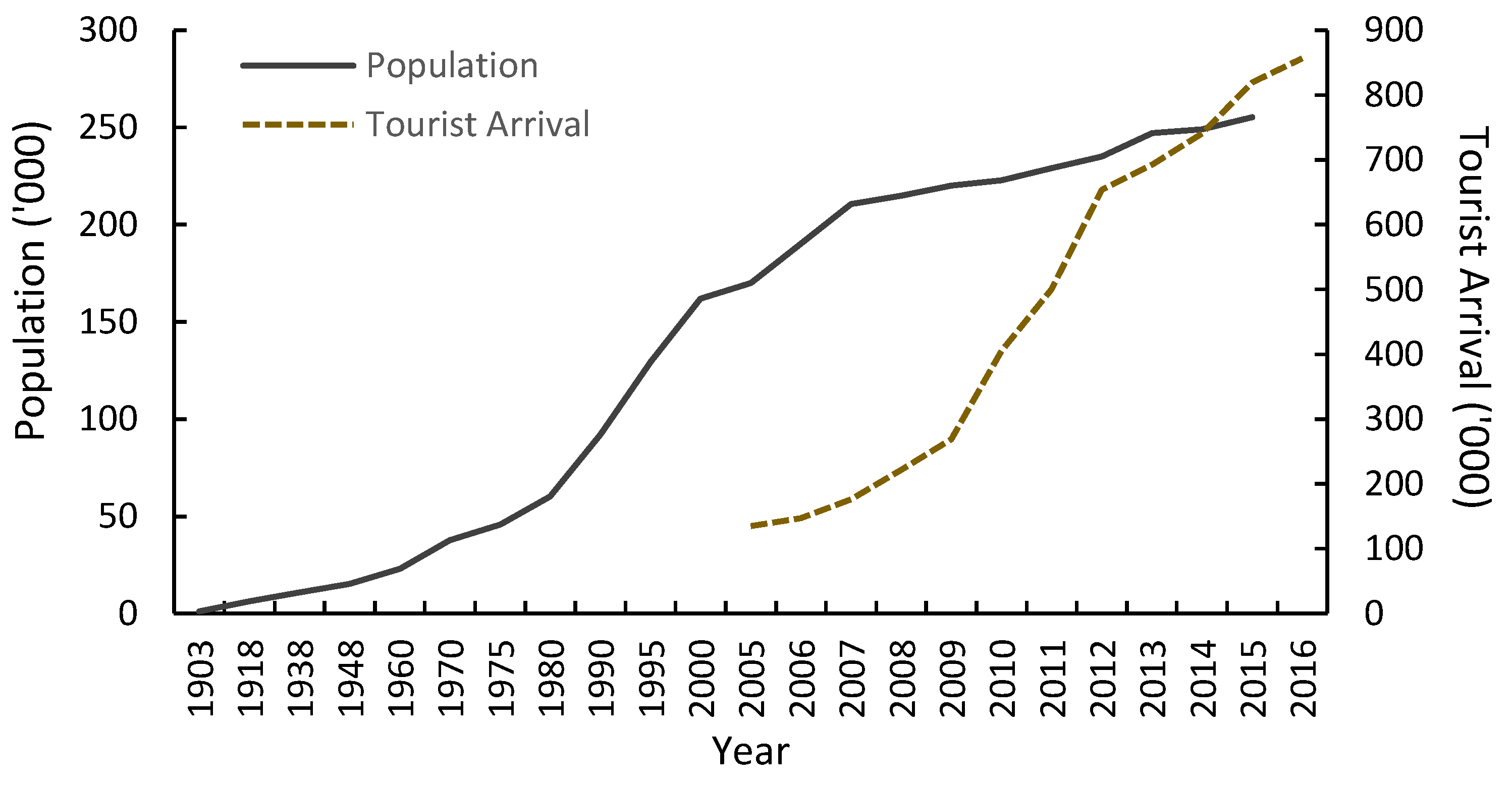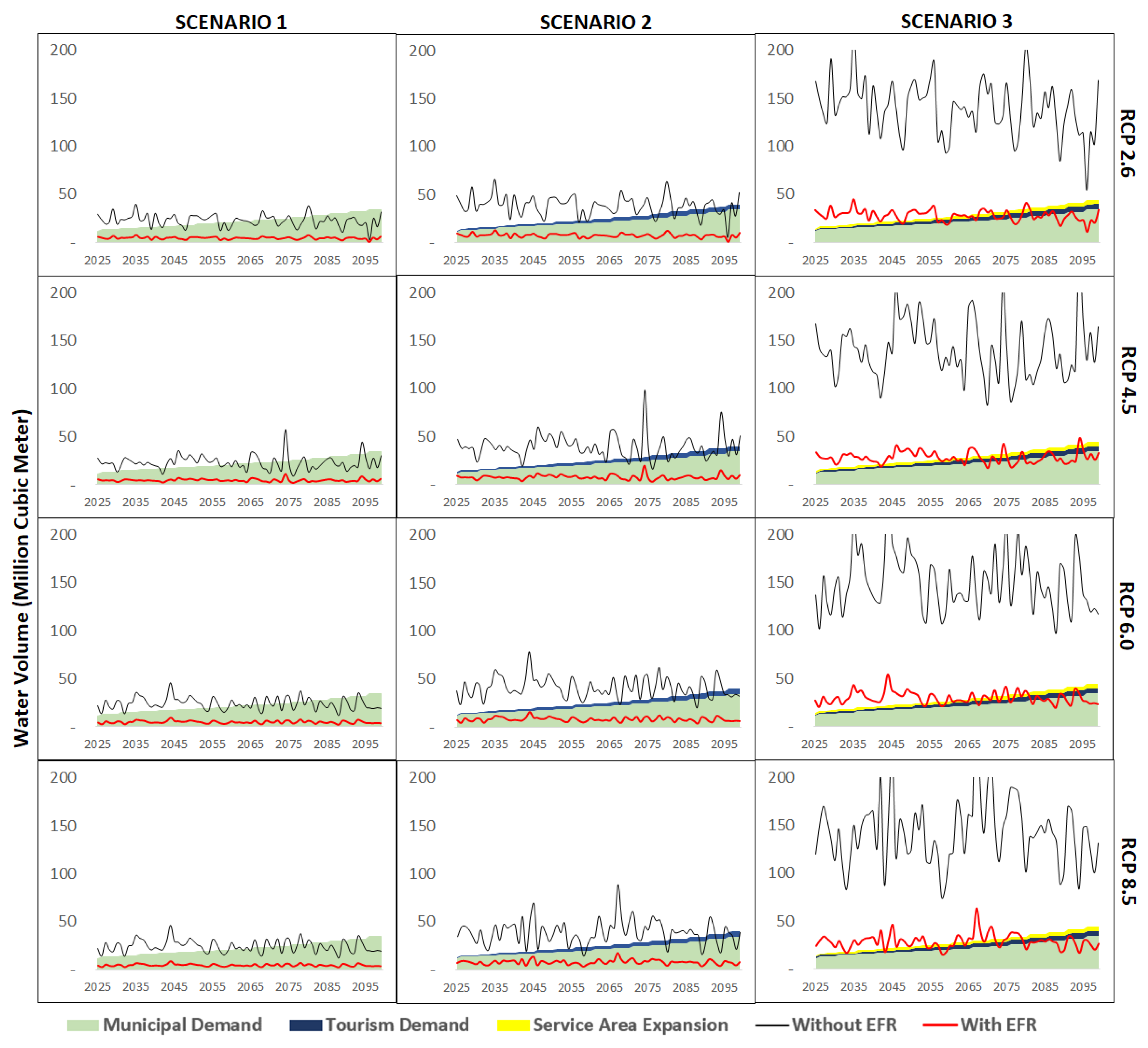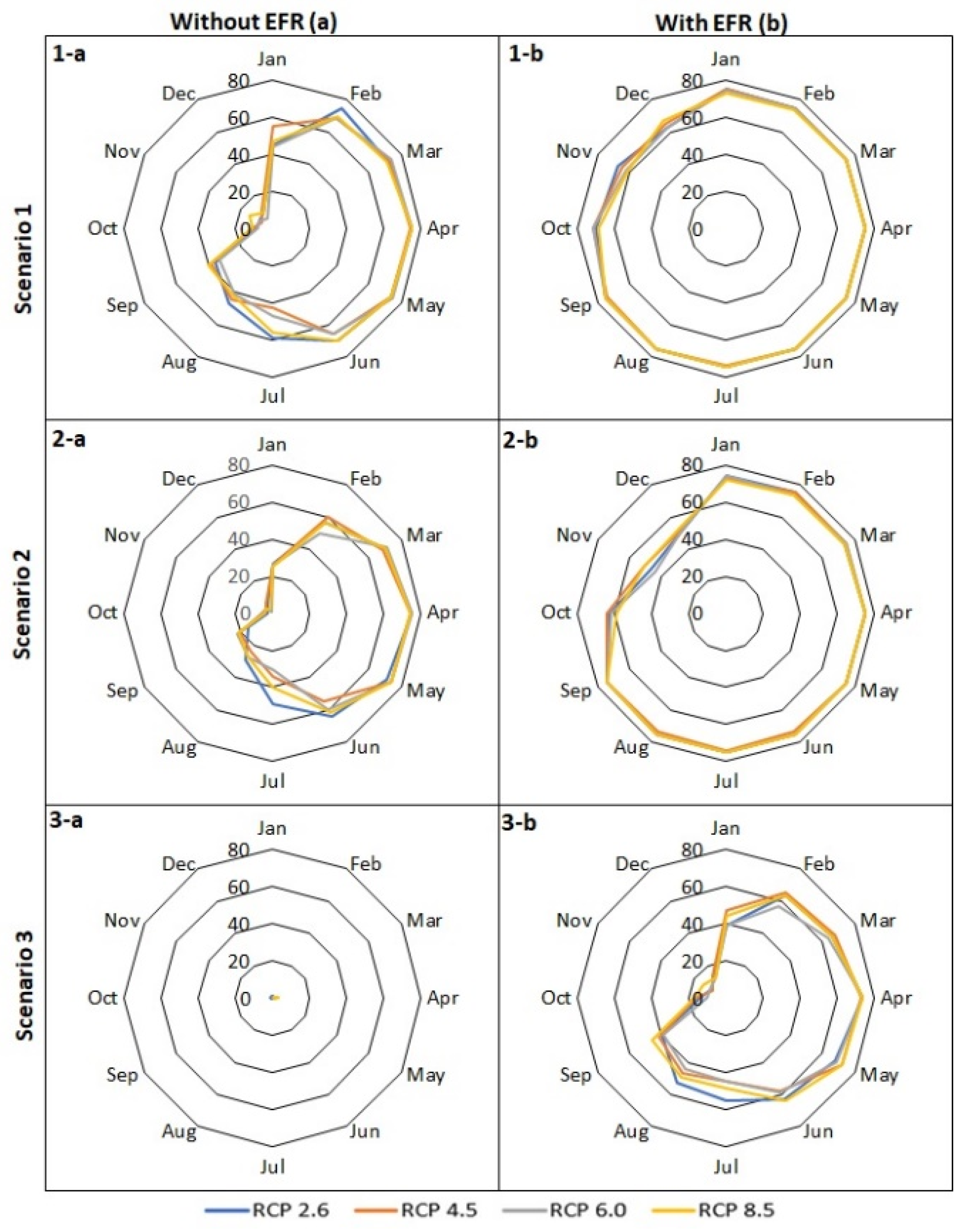This study involves three steps: (1) assessment and projection of water availability and water demand, (2) model calibration and evaluation, and (3) integrated scenario analyses. The hydrometeorological output of the Soil and Water Assessment Tool (SWAT v.12, developed and supplied by the United States Department of Agricultural Research Service at the Blackland Research & Extension Center in Temple, Texas, USA) was used to determine water availability [
21]. Water demand was classified as domestic, commercial, institutional, and tourism based on population and tourist arrivals. The accuracy of the predicted water yield was evaluated using the Nash–Sutcliffe efficiency (NSE) and coefficient of determination (R
2), and the projections of the demand models were determined using the mean absolute percentage error (MAPE). In step (3), the potential of surface-water supply, that is, sufficiency or deficiency, was assessed for the three scenarios.
3.1. Water Availability
The surface water available at three watersheds (Irawan, Lapu–Lapu, and Montible) was determined using the SWAT model [
21,
22,
23] and computed using Equation (1). Watersheds were subdivided into subbasins using a river network map (
Figure 3). Despite the sudden increase in tourist arrivals since 2009, the assumptions for planning and designing water-supply systems have remained unchanged, thereby ignoring the changing water consumption patterns. Sub-basins were then further divided into hydrological response units, which consist of large areas with unique combinations of soil, land use, and slope.
where SW
t and SW
0 indicate the final and initial soil water contents, respectively, t is the time (days), R
day is the precipitation, Q
surf is the surface runoff, E
a is the evapotranspiration, w
seep is the water entering the vadose zone from the soil profile, and Q
gw is the return flow. The unit of all parameters is mm, and i represents the parameter value for a day.
Baseline (1980–2017) daily rainfall, relative humidity, and temperature obtained from the Philippine Atmospheric Geophysical and Astronomical Services Administration’s (PAGASA) Puerto Princesa Synoptic Station were used. The study region has only one weather station that is situated approximately 13 km away from the Irawan watershed (WS) and 21 km from the Montible WS. The future climate data obtained from the simulations of the Hadley Center Global Environment Model2–Earth System (HaDGEM2–ES) global climate model, were subjected to bias correction through the intersectoral impact model intercomparison project–fast track (ISIMIP–FT) framework [
24,
25], and four representative concentration pathways (RCPs) such as RCP2.6, RCP4.5, RCP6.0, and RCP8.5 were used. Additional and equally essential input data are listed in
Table A1.
The first five years of the baseline and future simulations (1980–1984 and 2015–2019, respectively) were used as warm-up periods. Note that the data used for calibration (1980–1990) and validation (1991–1999) were generated using a water balance approach based on the actual observations of Pennoni et al. (2002) [
26]. On the other hand, the Lapu–Lapu WS was neither validated nor calibrated due to a lack of data. The calibrated parameters from the Irawan WS were simply transferred because of its proximity and comparable topography, soil, and land use.
Automatic calibration, validation, and uncertainty analyses were performed using the sequential uncertainty fitting algorithm version 2 (SUFI-2) in the SWAT calibration and uncertainty programs package [
27]. The model was evaluated using monthly discharge by computing R
2 and NSE values [
28]. The suggested statistical thresholds are shown in
Table 1.
In the absence of clear standards for setting EF in the Philippines, this study adopted a presumptive standard that allowed up to 20% of annual and monthly flows for alteration, maintaining 80% of flows to sustain ecological health [
29].
3.2. Water Demand
Population is the primary data used for determining conventional municipal water demand (domestic, commercial, and institutional demand sectors) in a service area [
30]. This was projected geometrically from the 2015 census. The projected municipal growth rates used were computed using the ratio method from the projected provincial growth rates until 2045 obtained from the Philippines Statistics Authority. The absence of longer projected growth rates enabled us to use the 2045 growth rate until 2100 projections [
31,
32].
A stylized model [
33] (Equation (2)) was used to capture the tourism sector’s water demand (corresponding to the business as usual (BAU) scenario) and to determine the total municipal demand. Each demand type was determined using Equations (2a)–(2g). Commercial and institutional consumers were determined proportionally to the population [
30]. All water-use factors (WFs) were determined from consumption records. The lack of water consumption records for the year 2000 and before limited the validation to focus on demand Scenario 2 (BAU scenario) only.
where TotD
t is the total water demand in the service area per unit time t (m
3/t), DD
t is the domestic demand in the service area per unit time t (m
3/t), CD
t is the commercial demand in the service area per unit time t (m
3/t), ID
t is the institutional demand in the service area per unit time t (m
3/t), and TD
t is the tourism demand in the service area per unit time t (m
3/t).
Domestic demand (DD
t) is the utilization of water directly drawn from a source or supply system by a household for drinking, washing, bathing, cooking, and watering of gardens, or by animals and other domestic uses. Thus, it is entirely driven by the population and calculated using Equation (2a) [
30].
where DD
t is the domestic demand per unit time t, P
t is the population per unit time t, and DWF
t is the domestic water use factor per unit time t. A provincial-level projected population growth until the year 2045 was obtained from the Philippine Statistics Authority (PSA), which accounts for the demographic changes occurring in each province, such as fertility, mortality, and migration. These data absent at the municipal/city level, making it impossible to use such a method. Alternatively, the population was projected using a geometric Equation (2b) by utilizing population growth rates [
30]. The projected municipal growth rates were calculated using the ratio method [
31,
32] to that of the projected provincial growth rates from the PSA until 2045. Constant growth rates were applied for succeeding years, which is equal to the last projected growth rate (2045). The initial population was based on the 2015 census population.
It is assumed that services cover 90% of the 74% population within the city in 2015 (74% of the households in 2015 resided within the service area; based on interviews with water company managers), and the services will be expanded to neighboring villages. The DWF was calculated as 152 L per capita per day (lcpd), or 0.152 m
3 day
−1, based on the 2016 consumption records of the PPCWD. According to the Local Water Utilities Administration (LWUA) [
31], this value is projected to increase by 5% every five years.
Commercial water demand (CD
t) includes all other private businesses and industries. It is determined by the number of commercial connections that can be derived from the ratio of commercial establishments to the population in the service area [
30]. There is a relationship between the number of commercial–industrial connections and the service area population, which varies between 0.3 and 1.2 connections per 100 population [
31]. Based on the 2016 records of the PPCWD, a ratio of 0.36 commercial connections per 100 inhabitants (excluding accommodation establishments (AEs)) was used. The commercial connections could then be used to assess the commercial water demand using Equation (2c,d) as follows:
where CWF
t is the commercial water use factor per unit time, t. The CWF
t is benchmarked in the year 2000 records and projected to increase by 2% annually. This year is the earliest consumption record collected, which was when the effect of tourism on commercial water consumption was still negligible (i.e., 0.17% of the population comprises daily tourists). The 2015 CWF was determined as 1.9 m
3 conn.
−1 day
−1, and this value was used to predict the succeeding years with a 5% increase every 5 years [
31].
where C
t is the number of commercial connections per unit time t, P
t is the population per unit time t, and CD
t is the commercial demand per unit time t.
The institutional water demand (ID
t) includes water requirements from schools, churches, public administration buildings, and hospitals, and it was calculated using Equations (2e,f). The underlying assumption is that there is one institutional connection per 2000 inhabitants. Based on the PPCWD 2016 records, the calculated IWF is 13.41 m
3day
−1connection
−1 and it is projected to increase by 2.6% every 5 years [
31].
where I
t is the number of institutional connections per unit time t, P
t is the population per unit time t, ID
t is the institutional demand per unit time t, and IWF
t is the institutional WF per unit time t.
Tourism water demand (TD
t) is the consumption determined from AEs [
11,
12,
15,
34,
35]. There are significant differences in water consumption depending on the type of accommodation (hotel, campsites, bed and breakfast, resort, etc.) and tourist activities. This study adopted the City Tourism Office’s (CTO) AE classification (hotels, tourist inns, pension houses, and resorts). The monthly water consumption was determined from a purposive stratified sample of 82 AEs within the service area based on the 2017 PPCWD records. Based on the CTO’s report, the average overnight stay period per tourist per AE type is 1.6 nights (the average length of stay of a tourist in the city per visit). The average tourist water consumption factor (TWF
j) at each AE type per tourist per overnight stay was then computed using a simple arithmetic mean (Equation (2h)). This value was held constant throughout the forecast period because the literature on variations in tourist water consumption was not available. The monthly and annual water consumptions were computed using Equation (2g) as follows:
where TD
t is the tourism water demand per unit time t, F is the predicted number of tourists at time t, TWF
j is the tourism water consumption factor, j is the AE type, n is the total number of samples, and a is the water consumption at time t (WC
jt) divided by the total number of guest night stays at time t (TOS
jt) of each accommodation.
Tourist arrivals simulation (Equation. (3)) was first calibrated and validated using the Holt–Winters exponential smoothing curve [
36] fitted to the observed monthly tourist arrivals from 2005 to 2017. A fitted curve was used to predict future tourist arrivals. The average overnight stay was determined from sampled AE occupancy records. It was then added to the conventional total simulated municipal demand and subjected to validation.
where y
t denotes the actual observation, S
t is the smoothed observation, b
t is the trend factor, I
t is the seasonal smoothing, F
t+m is the forecast at m periods ahead, t is an index denoting a time period, L refers to the number of data points that indicate the beginning of a new season, and α, β, and γ are constant values between 0 and 1 that must be estimated such that the error is minimized.













